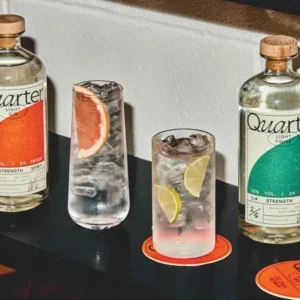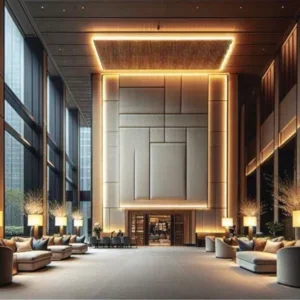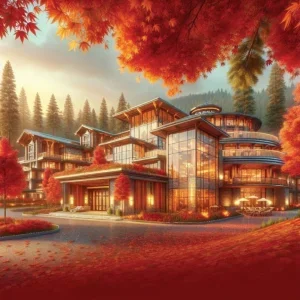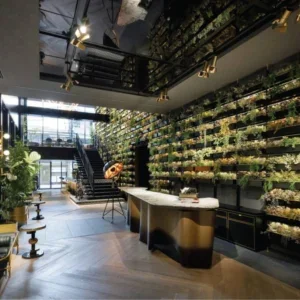Massimo Ferragamo, chairman of Ferragamo and son of shoe legend Salvatore, is a man of very fine tastes. The iconic Italian label is larger than ever, partly due to the demand for its goods in Asia-Pacific, but aside from assisting in the growth of his family’s fashion house, Massimo Ferragamo has been busy in recent years working on a totally different project: the Castiglion del Bosco. Nestled high on a Tuscan hill just a short distance from Siena, these luxury villas and suites have been elegantly renovated by Ferragamo and his wife, Chiara.
"I couldn’t imagine doing this any place else," he explains. "But then Tuscany somehow seems to be a part of all our interior landscapes without us even knowing it, and without necessarily having to be Italian; we somehow understand the beauty. It is a magical combination of elements that just doesn’t exist anywhere else in the world."
Residing in the heart of the coveted Brunello wine region, the estate’s Capanna vineyard on the southern side of the property was reputedly one of the major selling points that convinced Ferragamo to buy it in the first place.
"I thought, looking at the land, and what was a huge combination of real estate and wine, that they could help each other," Massimo explains. "I was greatly motivated by a desire to bring the land back to life. It’s very rare to get an opportunity like this in Italy."
Perfectly placed
Nine large villas and 23 impeccable suites are nestled around the heart of the property, while 12th-century ruins piled high on a hill overlook the surrounding estate. Once the home of a wealthy merchant family from Siena, the castle was constructed for its perfectly placed view of the pilgrimage route from Canterbury to Rome along which it resides. It was undoubtedly a stunning residence some 800 years ago and below its steps is the ‘Borgo’ (which literally translates into village), a series of 17th and 18th-century farmhouses that have been renovated into stunning suites by Ferragamo.
Previously available for Castiglion del Bosco members, this year sees the gates of this property in the middle of the Val d’Orcia National Park open to the public as well. A cobbled lane leads guests between the spa and the restaurants, the shop (where all merchandise is hand-picked by Chiara Ferragamo) and the varying suites built into two large buildings, one of which was the estate owner’s home, the other the original winery for the Borgo.
The majority of the site’s 4,200 acres are untouched and the properties have been restored with absolute authenticity. Externally, each building has been carefully restored to reflect its original glory. For example, inside what was once the estate owner’s home and is now the new presidential suite, the former ballroom has been turned into a beautiful dining and living room area.
"I wasn’t interested in copying anything that had been done before. I think it’s a duty to bring this place back to what is historically correct. When we finished, it needed to look like we’d never stepped inside."
Living areas with roaring fires add warmth to neighbouring, regal bedrooms, while shuttered windows open onto views of the Borgo’s charming cobbled thoroughfare, and most villas look across the vineyards to nearby Montalcino. The property is tranquil and instantly calming, proving very popular with celebrity guests who want privacy; some villas are located up to five kilometres from the Borgo, so one really has the sense of being on holiday alone in the middle of the Tuscan countryside.
"Tuscany is beautiful," muses Massimo, "with a nice climate, good wine and places to visit. Castiglion del Bosco is a way of experiencing the real Tuscany from the ‘front row’."
Gastro heaven
The property’s two restaurants offer delicious Italian cuisine: Ristorante del Drago serves classic Tuscan fare in a formal but utterly beautiful setting, while La Canonica is a typical Italian Trattoria, creating dishes such as perfect Caprese salad and homemade spaghetti (and the property’s olive oil is some of the finest I have ever tasted). Originally the local priest’s house, it is also home to the property’s cooking school. The heart of La Canonica is a demonstration kitchen, designed by noted Florence-based craftsman Riccardo Barthel.
Just outside its wooden doors is the ‘Orto’ (kitchen garden) where more than 180 vegetables grow, all hedged with tiny wild strawberry bushes. Among the produce cultivated here are some that are unique to this region of Tuscany, including round Florentine fennel, wild chicory and curly endive.
Guests keen to hone their traditional Tuscan cookery skills can take lessons with in-house chefs all under the direction of executive chef Moreno Miotto, utilising whatever they have picked from outside. Miotto’s aim is to share the essence of the region’s delicious, simple, traditional dishes so that guests can replicate them at home.
Elsewhere within the grounds of Castiglion del Bosco is a small organic farm where meat and dairy animals are bred for the restaurant. These include pigs and pigeons, and the farm is surrounded by the vast hunting grounds of the estate – mostly for the benefit of the guests – where pheasants can be seen scurrying about. In the autumn you can look for truffles.
Fine wines
While the northern vineyards’ clay soil and humid atmosphere produce delicious day-to-day wines such as the Rose de Montalcino, the southern, rockier soils, located at a higher altitude and cooled with a gentle sea breeze, are ideal for making Brunello.
The microclimate is hot and dry in the summer and more humid in the winter and spring. As a result, the wines are refined and elegant. The soil is characterised by the presence of sandstone, layers of clay and galestro, a typical Tuscan stone, and the richness of the galestro stone in the soil gives the wine its unique aroma, complexity and structure. A complex wine released five years after production, Brunello is created using coveted Sangiovese grapes from the area and is stored underneath the property’s new winery (the original has now been transformed into suites.) until it is ready for release.
All members have private wine lockers in the round members’ room, which initially strikes one as a setting from an Ian Fleming novel, where bottles can be sampled and temperatures are strictly controlled. The pinnacle of Castiglion del Bosco’s wine production is the Campo de Drago, named after the vineyard on the property and produced only when the harvest is perfect. The winery is overseen by local oenologist Cecilia Leoneschi, a curly-haired, youthful Tuscan woman whose passion for wine and knowledge emanates as she speaks. She is a perfect guide for those looking to buy or simply learn more about the local area’s wine-producing history.
Space to relax
The wealth of local produce even makes its way beyond the kitchen to the spa. The Daniela Steiner spa offers therapies and uses products based on organic ingredients grown in the Orto. Ingredients are seasonal; past elixirs have featured Brunello grape must and Bacchus nectar. Everything from slimming body treatments to eyebrow tinting and luxury facials to pedicures are available using these kinds of products and, as the popularity of Castiglion del Bosco grows, I wouldn’t be surprised to find out that the spa had been extended, although its intimate size makes it a cosy, pampering space.
Castiglion del Bosco members undoubtedly played a large part in the property’s initial development and there are still openings for those interested in investing. Those not looking for a long-term commitment can book in as guests for a relaxing weekend or a villa-based summer holiday; the Ferragamos and their children are likely to be there too as they visit from their New York base regularly. I only had two days and nights myself, but even that afforded me time to explore the vineyards, eat to bursting point in the gorgeous restaurants and really enjoy my suite’s enormous bathtub. The property is beautiful and convinced me that the Ferragamos’ magnificent attention to detail would ensure that the family’s legacy would not only be associated with Salvatore’s shoe designs.






